Barn
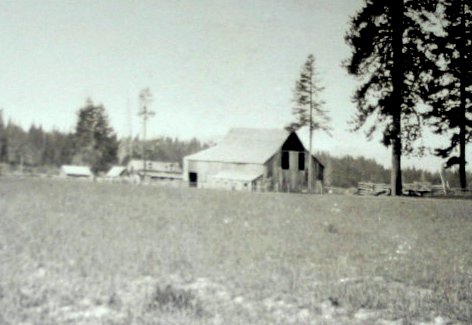 The main part of the barn was used to store hay.
But right after harvest the hay filled everything, including the sheds.
No animals stayed in the barn except in extremely cold weather.
There were sheds built onto the barn on both sides and in the back.
The photo to the right shows the barn from the front, with the Homestead in the
background. The shed on the left was for milking the cows in the winter and the other shed was for horses
and tack (saddles, harnesses etc.). The shed at the back of the barn was for shearing sheep
and other things. The Vandeverts had only a few head of sheep.
They sheared them once a year and sold the wool.
The main part of the barn was used to store hay.
But right after harvest the hay filled everything, including the sheds.
No animals stayed in the barn except in extremely cold weather.
There were sheds built onto the barn on both sides and in the back.
The photo to the right shows the barn from the front, with the Homestead in the
background. The shed on the left was for milking the cows in the winter and the other shed was for horses
and tack (saddles, harnesses etc.). The shed at the back of the barn was for shearing sheep
and other things. The Vandeverts had only a few head of sheep.
They sheared them once a year and sold the wool.
Big Bridge
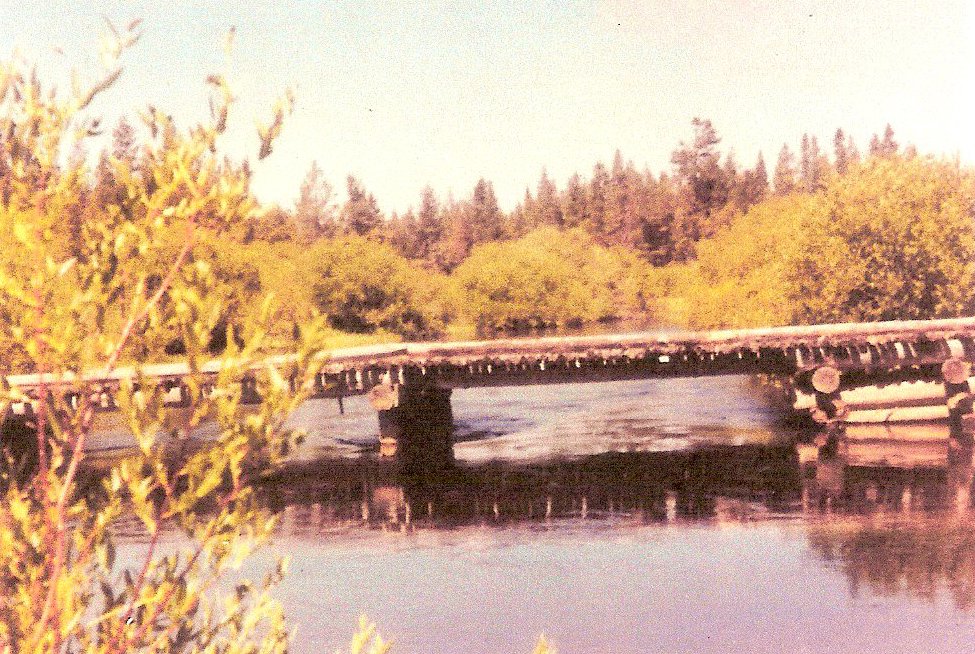 This bridge was used for moving cattle and vehicles across the river.
This bridge was used for moving cattle and vehicles across the river. 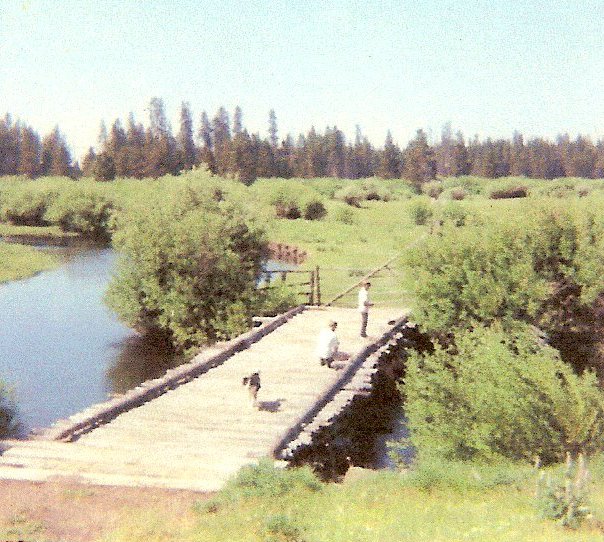
Big Ponderosa
In the early 1920’s, most of the ponderosa trees that populated the ranch were cut
and sold to the Shevlin-Hixon Lumber Company in Bend.
The family elected to keep a few of their favorites. One had the surrounding area named after it.
“Big Yellow Pine Tree Prairie” was at the south end of the property on the other side of the river from the house. .
Big Tree
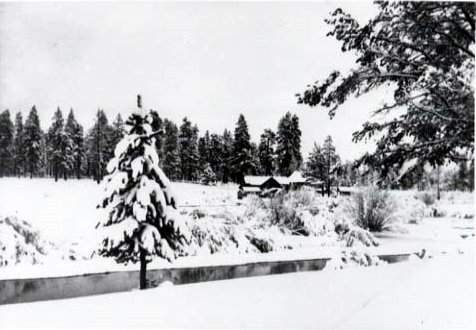 When the Vandeverts looked up the hill toward the front gate, an enormous ponderosa pine dominated the landscape.
It was a sad day when the tree was hit by lightning and had to be cut down.
The photo to the right shows the homestead from across the river in winter,
1921, before the most of the ponderosas had been logged and before the big
ponderosa (one of the trees behind or somewhat to the left of the house) had
been cut down.
When the Vandeverts looked up the hill toward the front gate, an enormous ponderosa pine dominated the landscape.
It was a sad day when the tree was hit by lightning and had to be cut down.
The photo to the right shows the homestead from across the river in winter,
1921, before the most of the ponderosas had been logged and before the big
ponderosa (one of the trees behind or somewhat to the left of the house) had
been cut down.Chicken Coop
The chicken coop was long and had entrances at either end. One half of the building was for chickens and the other half was for the turkeys. The family had a plentiful supply of eggs and sold some of them to bring in extra cash.Corral
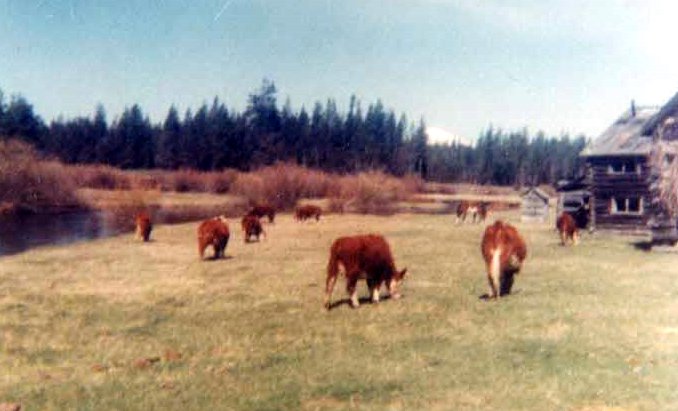 The big corral was for the beef cattle. They were up to eighty or ninety whiteface Herefords on the ranch at one time. The cattle were branded in the spring with the Hashknife brand that W.P. Vandevert had brought from Arizona.
At first the cattle summered near Davis Lake. But in the late 1920's the
Forest Service offered to open up land near the Spring River, west of Sunriver.
The family accepted the offer because the land was closer to the ranch.
The Vandeverts brought the cattle back to the ranch around October 15, partly to
make sure they weren't shot by deer hunters. In the 1940’s, when Camp Abbott was in operation on the current site of Sunriver, the cattle summered near Mt. Bachelor at Sparks Lake.
The corral was near the barn because the cattle ate hay from the barn all
winter. When it got really cold the cattle would get double feed.
They would be a little creaky in the morning but they all survived the cold.
After a heavy snowfall there appeared to be far fewer cattle on the land but a
surprising number of lumps in the snow. This photo of the whiteface Herefords appears to have been taken near the river
and not near the corral.
The big corral was for the beef cattle. They were up to eighty or ninety whiteface Herefords on the ranch at one time. The cattle were branded in the spring with the Hashknife brand that W.P. Vandevert had brought from Arizona.
At first the cattle summered near Davis Lake. But in the late 1920's the
Forest Service offered to open up land near the Spring River, west of Sunriver.
The family accepted the offer because the land was closer to the ranch.
The Vandeverts brought the cattle back to the ranch around October 15, partly to
make sure they weren't shot by deer hunters. In the 1940’s, when Camp Abbott was in operation on the current site of Sunriver, the cattle summered near Mt. Bachelor at Sparks Lake.
The corral was near the barn because the cattle ate hay from the barn all
winter. When it got really cold the cattle would get double feed.
They would be a little creaky in the morning but they all survived the cold.
After a heavy snowfall there appeared to be far fewer cattle on the land but a
surprising number of lumps in the snow. This photo of the whiteface Herefords appears to have been taken near the river
and not near the corral. Corral for Milking
The ranch kept cows for milking until the late 1960's. The Vandevert family consumed most of the milk itself but sold or traded some of the milk with neighbors.Dirt Road by Front Gate
When the family left the front gate going north or south, they drove at an angle along the fence to meet the main road. There were several acres of property here that weren’t used for anything.Return to Ranch Map circa 1935
Continue to Points of Interest Page 2
Note: Black and white photographs are the property of Grace Vandevert McNellis and are used
by permission.
Text quoted from her book is copyright 1999 by Grace McNellis.
All other copy and art is copyright 2005-2010 by T. Haynes & G.V. McNellis. Neither the The Vandevert Ranch Associationnor its members guarantees
the accuracy or completeness of information or representations on this Web
Site. Buyers should obtain definitive information from their
real estate agent.